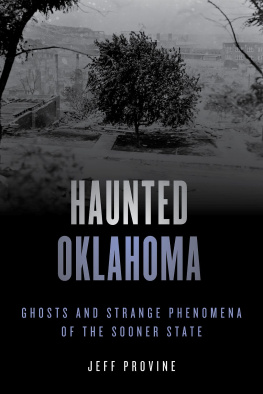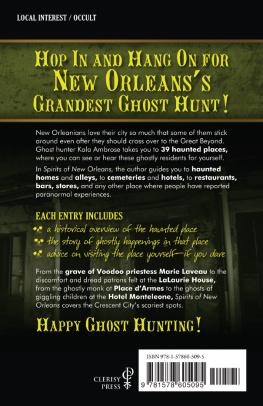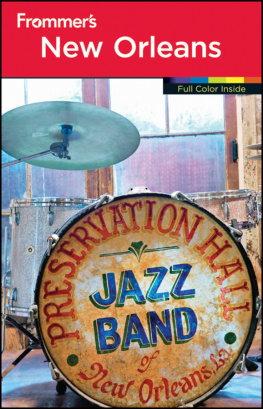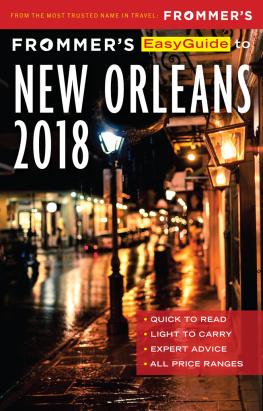About the Author
Bonnye E. Stuart is a ninth-generation New Orleanian and a member of the very large Perret family. She grew up in the city amid Mamma, Grandma and Grandpa, thirty-nine first cousins, and lots of aunts and uncles. Her four children were all born in New Orleans as tenth-generation Perret children. Last year an eleventh-generation boy made his appearance in New Orleans. Stuart got her bachelors degree in advertising from the Manship School of Journalism at Louisiana State Universitygo Tigers!and earned her masters degree in communication at the University of New Orleans. She writes short stories, poems, and plays, many of which are based on her life and family in New Orleans, and currently teaches at Winthrop University in South Carolina.
HAUNTED NEW ORLEANS
Copyright 2012 by Morris Book Publishing, LLC
ALL RIGHTS RESERVED. No part of this book may be reproduced or transmitted in any form by any means, electronic or mechanical, including photocopying and recording, or by any information storage and retrieval system, except as may be expressly permitted in writing from the publisher. Requests for permission should be addressed to Globe Pequot Press, Attn: Rights and Permissions Department, PO Box 480, Guilford, CT 06437.
Text design: Sheryl P. Kober
Editor: Tracee Williams
Project editor: Lauren Brancato
Layout: Sue Murray
Library of Congress Cataloging-in-Publication Data
Stuart, Bonnye E.
Haunted New Orleans : Southern spirits, garden district ghosts, and vampire venues / retold by Bonnye Stuart.
p. cm.
Includes bibliographical references.
ISBN 978-0-7627-6437-2
1. Haunted placesLouisianaNew Orleans. I. Title.
BF1472.U6S779 2012
133.109763'35dc23
2012008252
Printed in the United States of America
10 9 8 7 6 5 4 3 2 1
To wondrous spirits of my own past, may they rest in peace and serenity
ACKNOWLEDGMENTS
This manuscript was due on All Saints Day, an important religious holiday celebrated by New Orleans Catholics. Its significance as a way to connect with those who have the ear of God crosses all geographic, economic, social, and political boundaries. Even sports fans celebrate the Saints. We pray to those who have achieved perfection and beatification to help us here on earth. We pray for health, wealth, good fortune, and a winning season.
On All Saints Day, November 1, many people visit cemeteries to pray for special help from loved ones who are thought to have entered the Pearly Gates. But for some New Orleanians November 2 is the day they set aside to visit the cemetery. On the Feast of All Souls or, more officially, the Commemoration of All the Faithful Departed, people dont pray to loved ones, but rather for them. Also called the Day of the Dead, this day is dedicated to those souls who have passed over but remain in purgatory to atone for sins committed on earth. They can be helped by earthly prayers, novenas, intercessions, and Masses in their honor. On this day New Orleanians visit the grave sites of their loved ones and pray that their souls may rest in peace. Its also the time to spruce up the place. Family members bring fresh flowers, both real and plastic, vases are cleaned of mold and mildew, weeds are pulled, debris is removed, and Mardi Gras beads are often hung on tombstones to give those buried there something to look forward to after the cold, damp winter days are over. No wonder that New Orleans has earned the title of the most haunted city in the world. Praying for Souls, petitioning Saints, speaking to the Dead, celebrating festivals with family and friends entombed in aboveground mausoleums, an occasional gris-gris curse when things arent going so wellits all part of life in New Orleans. When I opened my Facebook page on All Souls Day, I had two pictures of my mothers grave site, one from each of my sisters. The flowers were beautiful and plentiful and, yes, there were new doubloons and Mardi Gras beads decorating the area.
I would like to acknowledge my city, New Orleans, for cultivating my long heritage within its loving arms. I am a ninth-generation New Orleanian, and the citys customs, folklore, mores, and superstitions are in my blood. I have visited, eaten at, imbibed at, stayed in, and celebrated many of the places in this book. Some of the stories include real details of true occurrences; only those closest to our family will recognize them. Im not sure I believe all the tales I came across, but I do know that in New Orleans there are often and everywhere unexplainable happenings and odd sightings.
I would like to thank all the writers of all the stories, books, histories, websites, journals, and newspaper articles that gave me such incredible information from which to extract these tales. Winthrop University has been a great help in getting books and articles for me from all over the country.
My deepest love and gratitude go to my immediate family, which is ever expanding: David, Ruby, Lilli, Elizabeth, Jeff, Jack, Tennyson, Jessica, Frank, Emily, Lauren, Braden, Christian, Jessica Lee, Kingston, and a baby boy on the way. There are others to thank, but the list is getting too long. You know who you are. You have supported me through the process and forgiven my negligence due to looming deadlines. Special thanks and love go to my husband, Laurence, who keeps all things going at home, reminds me to take my phone with me, and always has my coffee ready in the morning.
INTRODUCTION
Do you agree that, when we speak of a ghost, we imply the preceding existence of something or someone corporeal? That is, something or someone having had a body before that thing or person achieved ghostliness? Yes or no?
Seamus Deane, Reading in the Dark
Romantic, carefree, spicy, eccentric, sultry, mysterious, garish, wondrous, exotic, fabulous, strange, extraordinary, eerie, quaint, and spooky, this is New Orleans. The list could be, should be, longer. Time often clouds memory, but early descriptions of the city, her people, and her long and tumultuous past are recorded in numerous history books, letters, and legal documents. Over the past three hundred years, the city herself has endured, undulating through each successive wave of change, whether individual, governmental, or natural, to emerge strong and vibrant. Many forces have tried, some successfully and others unsuccessfully, to alter the unique New Orleans way of life. The words of the living have recorded her story, but many spirits have stayed behind to relive the past in the present. They have been around since the beginning.
The citys early French history was rooted in staunch Catholicism and reinforced by the Spanish. Praying to saints, long dead, to intercede for the living was a consolation for the unfortunate. When African slaves and Haitian refugees arrived, they brought with them religious practices, many based on superstition and voodoo. A Creole culture developed, drawing on the best and worst of both worlds as believers sought to alleviate pain and suffering.
And New Orleans was a place of much suffering. Soggy, mosquito-infested swamps, deadly reptiles, intense heat, and rampant disease were a part of life for the early settlers. Sister Madeleine Hachard, one of the first Ursuline nuns to arrive in the colony, writes, From these woods come clouds of mosquitoes, gnats, and another kind of fly.... These wicked animals bite without mercy. These wicked animals brought malaria and yellow fever and death. Many died too young, and families fearing for their children turned to prayer and incantation. African slaves beseeched voodoo priests and priestesses for delivery from cruelty, forced separation from loved ones, and tortured death. Hurricanes, fires, epidemics, hardship, New Orleans experienced it all. The city was always wetwater lurking below the surface or floodwaters inundating her streets.






![Schwam - Frommers New Orleans [2011]](/uploads/posts/book/250009/thumbs/schwam-frommer-s-new-orleans-2011.jpg)




